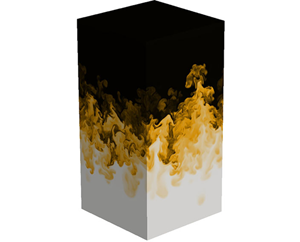Crossref Citations
This article has been cited by the following publications. This list is generated based on data provided by
Crossref.
Zhao, Zhiye
Wang, Pei
Liu, Nan-Sheng
and
Lu, Xi-Yun
2021.
Scaling law of mixing layer in cylindrical Rayleigh-Taylor turbulence.
Physical Review E,
Vol. 104,
Issue. 5,
Luo, Tengfei
and
Wang, Jianchun
2021.
Effects of Atwood number and stratification parameter on compressible multi-mode Rayleigh–Taylor instability.
Physics of Fluids,
Vol. 33,
Issue. 11,
Wang, Zhiying
Liu, Han
Gao, Qiang
Wang, Zhan
Wang, Yiwei
Wang, Guoyu
and
Shen, Lian
2021.
Numerical investigation of ventilated cavitating flow in the wake of a circular cylinder.
Physical Review Fluids,
Vol. 6,
Issue. 6,
Zhou, Ye
Williams, Robin J.R.
Ramaprabhu, Praveen
Groom, Michael
Thornber, Ben
Hillier, Andrew
Mostert, Wouter
Rollin, Bertrand
Balachandar, S.
Powell, Phillip D.
Mahalov, Alex
and
Attal, N.
2021.
Rayleigh–Taylor and Richtmyer–Meshkov instabilities: A journey through scales.
Physica D: Nonlinear Phenomena,
Vol. 423,
Issue. ,
p.
132838.
Yu, Jia-Long
Zhao, Zhiye
and
Lu, Xi-Yun
2021.
Non-normal effect of the velocity gradient tensor and the relevant subgrid-scale model in compressible turbulent boundary layer.
Physics of Fluids,
Vol. 33,
Issue. 2,
Mendez, Julio C.
Atkinson, Michael D.
Dhanasar, Mookesh
and
Ferguson, Frederick
2021.
A Formal Evaluation of a Consistent Averaging Procedure for Solving the Time-Dependent Navier Stokes Equations Numerically.
Fu, Cheng-Quan
Zhao, Zhiye
Xu, Xin
Wang, Pei
Liu, Nan-Sheng
Wan, Zhen-Hua
and
Lu, Xi-Yun
2022.
Nonlinear saturation of bubble evolution in a two-dimensional single-mode stratified compressible Rayleigh-Taylor instability.
Physical Review Fluids,
Vol. 7,
Issue. 2,
Tonicello, Niccolò
Lodato, Guido
and
Vervisch, Luc
2022.
Turbulence kinetic energy transfers in direct numerical simulation of shock-wave–turbulence interaction in a compression/expansion ramp.
Journal of Fluid Mechanics,
Vol. 935,
Issue. ,
Yan, Zheng
Fu, Yaowei
Wang, Lifeng
Yu, Changping
and
Li, Xinliang
2022.
Effect of chemical reaction on mixing transition and turbulent statistics of cylindrical Richtmyer–Meshkov instability.
Journal of Fluid Mechanics,
Vol. 941,
Issue. ,
Suman, Vajjala K.
Sundaram, Prasannabalaji
Puttam, J. K.
Sengupta, Aditi
and
Sengupta, Tapan K.
2022.
A novel compressible enstrophy transport equation-based analysis of instability during Magnus–Robins effects for high rotation rates.
Physics of Fluids,
Vol. 34,
Issue. 4,
Chen, Yuandong
Wang, Xiaoning
Duan, Lishu
and
Wang, Jianchun
2022.
Effect of heat source on kinetic energy transfer in compressible homogeneous shear turbulence.
Physics of Fluids,
Vol. 34,
Issue. 12,
Luo, Tengfei
and
Wang, Jianchun
2022.
Mixing and energy transfer in compressible Rayleigh-Taylor turbulence for initial isothermal stratification.
Physical Review Fluids,
Vol. 7,
Issue. 10,
Luo, Tengfei
Wang, Yunpeng
Yuan, Zelong
Jiang, Zhou
Huang, Wenfeng
and
Wang, Jianchun
2023.
Large-eddy simulations of compressible Rayleigh–Taylor turbulence with miscible fluids using spatial gradient model.
Physics of Fluids,
Vol. 35,
Issue. 10,
Qu, J.
Tao, Y.
Qiu, X.
and
Liu, Y.
2023.
Effects of heating and wall proximity on compressible flow around a cylinder
.
p.
12.
Munsi, A.
Kesarkar, A.P.
Bhate, J.N.
Rajasree, V.P.M
and
Kutty, G.
2023.
Helicity evolution during the life cycle of tropical cyclones formed over the north Indian Ocean.
Advances in Space Research,
Vol. 71,
Issue. 3,
p.
1473.
Qu, J.
Tao, Y.
Qiu, X.
and
Liu, Y.
2023.
Effects of heating and wall proximity on compressible flow around a cylinder
.
p.
12.
Fu, Cheng-Quan
Zhao, Zhiye
Wang, Pei
Liu, Nan-Sheng
Wan, Zhen-Hua
and
Lu, Xi-Yun
2023.
Bubble re-acceleration behaviours in compressible Rayleigh–Taylor instability with isothermal stratification.
Journal of Fluid Mechanics,
Vol. 954,
Issue. ,
2023.
Numerical study of the high-intensity heat conduction effect on turbulence induced by the ablative Rayleigh–Taylor instability.
Physics of Fluids,
Vol. 35,
Issue. 5,
Zhou, Zhangbo
Ding, Juchun
Cheng, Wan
and
Luo, Xisheng
2023.
Scaling law of structure function of Richtmyer–Meshkov turbulence.
Journal of Fluid Mechanics,
Vol. 972,
Issue. ,
Aslangil, Denis
and
Wong, Man Long
2023.
Investigation of strong isothermal stratification effects on multi-mode compressible Rayleigh–Taylor instability.
Physics of Fluids,
Vol. 35,
Issue. 8,






